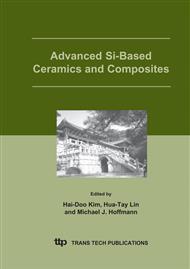p.96
p.102
p.108
p.112
p.117
p.123
p.129
p.135
p.141
Organic-Inorganic Solution Technique for Fabrication of Porous CaO-SiO2 Based Powders
Abstract:
Soft and porous CaO-SiO2 powders (CaSiO3, Ca2SiO4, Ca3SiO5) were fabricated by organic-inorganic solution technique. Calcium nitrate and Ludox SK silica sol were dissolved in D.I. water and then 5 wt% polyvinyl alcohol solution was added as a polymeric carrier. The metal cations were dispersed well in solution and a homogeneous polymeric network was formed. The organic-inorganic precursor gels were turned to porous powder having volume expansion through an explosive oxidation reaction during calcination process. The polyvinyl alcohol content and heating rate were affected on the explosive reaction behavior. It may be speculated that the reaction between oxygen and unstable calcium cations resulted in the vigorous exothermic reaction and simultaneously the reaction made extensive void, which is accompanied with volume expansion in the powder structure, by the thermal decomposition in a moment of organic substance, polyvinyl alcohol. The porous powders were crystallized at relatively lower temperatures, and the crystalline development was dependent on the polymer content.
Info:
Periodical:
Pages:
117-122
Citation:
Online since:
June 2005
Authors:
Keywords:
Price:
Сopyright:
© 2005 Trans Tech Publications Ltd. All Rights Reserved
Share:
Citation:


